Adinkra Symbols & Meanings: Explore African Symbols, Wisdom & Culture

What Are Adinkra Symbols?
Adinkra are visual symbols that represent concepts, proverbs, and aphorisms. They originated from the Akans of Ghana in the 1700s or before. Back then, they featured as prints on cloth which royals wore to important ceremonies. But they have transcended these Akan origins. They now grace logos, clothing, furniture, architecture, and more. These new usages embody a global recognition of their profound cultural significance.
Why Do They Matter?
Saturated with meaning, Adinkra have come to represent the richness of Akan culture in particular and African culture in general. They serve as a concise way to convey deep truths in visual form. In fact, many of the symbols have their own associated Akan proverbs. Their widespread adoption, especially among African Americans and other Africans across the diaspora, has solidified their status as icons of African symbolism and philosophy.
Notable Symbols
Popular Adinkra symbols include
- Gye Nyame, which expresses the omnipotence of God,
- Sankofa, which signifies learning from the past,
- Dwennimmen, which represents strength with humility, and
- Adinkrahene, a symbol for authority, leadership, and charisma.
Due to their appealing attributes, Adinkra symbols are often used in logos and emblems to promote ideas and causes. A notable example of this is the use of at least one Adinkra symbol in the coat of arms of many universities in Ghana, demonstrating the prestige that has come to be associated with their use.
Explore More
📜 Discover Adinkra symbols — explore their meanings with extra insights and context below.
📕 Download the Adinkra Symbols PDF — a handy guide with symbols, meanings, and commentary.
🛍️ Visit the Adinkra Store — find t-shirts, hoodies, mugs, stickers, and more Adinkra-inspired merch.
Search for a Symbol
Adinkra with Meanings: Explore African Symbols & Meanings
| Adinkra Symbol | Meaning |
|---|---|
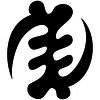
1. Gye Nyame |
Except God. A symbol expressing the omnipotence and supremacy of God. It is arguably the most popular Adinkra symbol in Ghana, reflecting the deep spirituality of its people. Gye Nyame is featured on Ghana's largest-denomination banknote, the 200 cedi note, as well as on the crests of the University of Cape Coast and the Catholic University College. |

2. Sankofa |
Go back and get it! A symbol for the wisdom of learning from the past to build for the future. From the Akan proverb, "Se wo were firi na wosan kofa a, yenkyiri," meaning, "It is not taboo to go back for what you forgot (or left behind)." While Gye Nyame may be the most popular Adinkra symbol in Ghana, Sankofa is the most popular one beyond the shores of Ghana, serving as a symbol of deep spiritual significance for many African Americans and other Africans in the diaspora who want to connect with their roots. Sankofa has two main representations: a bird and a stylized heart. The current one is the famous Sankofa bird, a mythical bird with its head turned backwards, holding an egg in its beak, while it appears to move forward. This depicts the importance of drawing lessons from the past to guide the present and the future. |

3. Sankofa |
This stylized heart with spirals is an alternative representation of the Sankofa symbol. The coils in the spirals represent returning to the past, one's roots, to draw lessons for the present and the future. |

4. Adinkrahene |
King of the Adinkra symbols. A symbol for authority, leadership, and charisma. Also a symbol for qualities associated with kings. Adinkrahene is reportedly the inspiration for the design of the other symbols. |

5. Dwennimmen |
Ram's horns. A symbol of strength (in mind, body, and soul), humility, wisdom, and learning. This symbol features prominently in the logo of the University of Ghana, Ghana's first and largest university. |

6. Funtumfunefu Denkyemfunefu |
Conjoined crocodiles. A symbol of unity in diversity giving a common destiny; sharing; from the proverb, "Funtumfrafu denkyemfrafu, wowo yafunu koro nanso wonya biribi a wofom efiri se aduane no de no yete no wo menetwitwie mu," to wit, Funtumfrafu and Denkyemfrafu share a stomach but when they get something (food) they strive over it because the sweetness of the food is felt as it passes through the throat. |
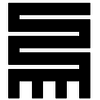
7. Nkyinkyim |
Twisting. A symbol representing the tortuous nature of life's journey and, also, the toughness, versatility, and dynamism required to thrive in it. Willis notes that it is also a symbol of dedication to service. |
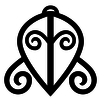
8. Odo Nnyew Fie Kwan (Odo Nyera Fie Kwan) |
Love does not lose its way home. Those led by love always end up in the right place. |
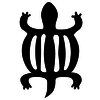
9. Denkyem |
Crocodile. A symbol of adaptability and cleverness. |

10. Nea Onnim |
He who does not know; from the proverb, "When he who does not know learns, he gets to know." It is a symbol of knowledge, life-long education, and continued quest for knowledge. |
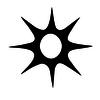
11. Nsoromma |
Star (literally, "child of the heavens"). A symbol of faith and the belief in patronage and dependency on a supreme being |

12. Aban |
Fortress (or castle). A symbol of strength, seat of power, authority, and magnificence. |
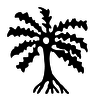
13. Abe Dua |
Palm tree. A symbol of wealth, resourcefulness, and self-sufficiency. |

14. Abode Santann |
Totality of the universe or the vast expanse of creation. A symbol of the totality of the universe--natural and social creation. From the expression, "Abode santann yi firi tete, firi Odomankoma; Odomankoma boo adee; oboo awia, osrane ne nsoromma, oboo nsuo ne mframa; oboo nkwa, oboo nipa, na oboo owuo. Ote saa daa," to wit, "This panorama of creation is from time immemorial, from God; God created things; he created the sun, the moon, and the starts, he created water and the wind; he created life, he created human beings, and he created death. He remains the same." According to Arthur, the symbol incorporates the eye, teh rays of teh sun, the double crescent moon, and teh stool. The sun, the moon, and teh eye depict natural creation by a supreme being while teh stool depicts the socially created institutions and teh creativity of human beings. |

15. Abusua Pa |
Good family. A symbol of family unity, kinship ties, and family support. From the expression, "Abusua pa mu na adoye ne koroye wo," to wit, "It is in a good family that we have love and unity." |
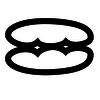
16. Adwo |
Calmness. A symbol for peace, tranquility, and quiet. |

17. Agyin Dawuru |
Agyin's gong. A symbol of faithfulness, alertness, and dutifulness. Designed to commemorate the faithfulness of one Agyin who was a dutiful servant and gong-beater of the Asantehene. |

18. Akoben |
War horn. A symbol of a call to action, readiness to be called to action, readiness, and voluntarism. |
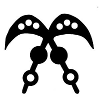
19. Akofena |
A sword of war (or the state ceremonial swords). A symbol of state authority, legality, the legitimized authority of a ruler, recognition of gallantry of heroic deeds. Ghana's coat of arms shows one of these ceremonial swords crossed with a linguist's staff in its top left quadrant. |

20. Akoko Nan |
The foot of a hen. A symbol for discipline coupled with care and nurturing; from the Akan proverb, "Akoko nan tia ba na enkum ba," literally, "The foot of a hen steps on the child (chick) but it doesn't kill the child (chick)." |
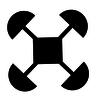
21. Akoma Ntoaso |
Joining of hearts. A symbol of agreement, togetherness and unity or a charter. An amplification of the concept of Akoma |

22. Akoma |
Heart. A symbol of love, goodwill, patience, faithfulness, fondness, endurance, and consistency. |

23. Ananse Ntentan (Ananse Ntontan) |
Spider's web. A symbol of wisdom, craftiness, creativity, and the complexities of life. It is the web of Ananse, the crafty spider who is preeminent in African folklore. |

24. Ani Bere A Enso Gya |
No matter how red-eyed one becomes (i.e. how serious one becomes), his eyes do not spark flames. A symbol of patience, self-containment, self-discipline, and self-control. |

25. Anyi Me Aye A |
If you will not praise me. A symbol of ingratitude, ungratefulness, and boorishness. From the expression, "Anyi me aye a, nsee me din," to wit, "If you will not praise me, don't spoil my name (that is, undermine my integrity)." |

26. Aponkyerene Wu A |
When a frog dies. A symbol of significance, value, and importance. From the maxim, "Aponkyerene wu a na yehunu ne tenten" to wit, "It is when a frog dies that we see its (true) length." This speaks to the tendency to undervalue or underappreciate people or things until we lose them. |

27. Asaawa |
Sweet berry or miracle berry. A symbol of sweetness, sweet taste, pleasure, and hedonism. From the proverb, "Asaawa se: Ode nka anomu," to wit, "Sweetness does not stay in the mouth forever." |

28. Asase Ye Duru |
The earth has weight. A symbol of providence and the divinity of Mother Earth. |

29. Asetena Pa |
Good living. A symbol of conspicuous spending, indulgence, wealth, and upper social class. From the saying "Asetena pa ye awerefire," to wit, "Good living is forgetfulness (that is, good living makes one forget his humble beginnings)" |

30. Aya |
Fern. A symbol of endurance, independence, defiance against difficulties, hardiness, perseverance, and resourcefulness. |

31. Bese Saka |
Bunch of cola nuts. A symbol of affluence, power, abundance, and plenty. Also a symbol of togetherness and unity |

32. Bi Nka Bi |
Let no one bite the other. A symbol of justice, fairplay, freedom, peace, forgiveness, unity, harmony, and the avoidance of conflict or strife. |

33. Boa Me Na Me Mmoa Wo |
Help me and let me help you. A symbol of cooperation and interdependence. From the aphorism, "Boa me na me mmoa wo," to wit "Help me and let me help you" or, "Benkum dware nifa na nifa nso adware benkum," to wit, "The left (hand) washes the right and the right washes the left." |

34. Boafo Ye Na |
The rarity of a willing helper. It is a symbol of support, patronage, cooperation, and teamwork. "Boafo ye na," the popular Akan expression associated with this symbol, literally means "Helpers are rare" or "Helpful people are rare." |

35. Dame Dame |
Checkered. A symbol of craftiness, intelligence, and strategy. |

36. Dono Ntoaso |
The double dono; joined tension talking drum. A symbol of united action, alertness, goodwill, praise, rejoicing, and adroitness. |

37. Dono |
The tension talking drum. A symbol of appelation, praise, goodwill and rhythm. |

38. Duafe |
Wooden comb. A symbol of feminine consideration or good feminine qualities such as patience, prudence, fondness, love, and care. |

39. Dwantire |
Ram's head. A symbol of innocence and guiltlessness. From the proverb, "Dwantire se: Me tiri mu faa; okwasea bobonya menni fo nti na mabo hyire," to wit, "The head of the ram says: My conscience is free; the righteous fool who never tastes of guilt should not be dressed in black, hence, I am always in white." The idea here is that the guiltless fears no accusation. |

40. Eban |
Fence. A symbol of safety, security, and love. |
|
41. Epa |
Handcuffs. A symbol of law and justice. |

42. Ese ne Tekrema |
Teeth and tongue. A symbol of improvement, advancement, growth, the need for friendliness and interdependence. |

43. Esono Anantam |
Elephant's footprint. A symbol of leadership, protection, power, and security. From the aphorism, "Wodi esono akyi a, hasuo nka wo," to wit, "When you follow the elephant, you don't you are not touched by (you don't get wet from) the dew on bushes." |

44. Fafanto |
Butterfly. A symbol of tenderness, gentleness, honesty, and fragility. |

45. Fawohodie |
Freedom or independence. A symbol of freedom, independence, emancipation, self-determination, and self-government. From the proverb, "Fawohodie ne obre na enam," literally, "Freedom walks with suffering," that is, "Freedom or independence comes with responsibilities." |

46. Fihankra |
An enclosed or secured compound house. A symbol of brotherhood, safety, security, completeness, and solidarity. |

47. Fofo |
A flowering plant (bidens pilosa). A symbol of warning against jealousy and covetousness. |

48. Gyawu Atiko |
The back of Gyawu's head. A symbol of valor and bravery. Used interchangeably with the Kwatakye Atiko symbol. |

49. Hwehwemudua |
Measuring rod (rod of investigation) or rule. A symbol of excellence, superior quality, perfection, knowledge, and critical examination. |

50. Hye Wo Nhye (Hye Anhye) |
Burn you won't burn (fig. unburnable). A symbol of toughness and imperishability; also a symbol of permanence. |

51. Kete Pa |
Good bed. A symbol of good marraige, successful marriage, and good care. From the expression, "Obaa ko aware pa a na yede no to kete pa so," to wit, "It is when a woman enters a good marriage that she is put on a good bed." |

52. Kokuromotie |
Thumb. A symbol of cooperation, participation, teamwork, indispensability, and harmony. From the proverb, "Yensiane kokuromotie ho mmo po," to wit, "We don't bypass the thumb to tie a knot." Anybody who tries the exercise of tying a knot without his thumbs quickly appreciates this proverb. |

53. Kramo Bone Amma Yeanhu Kramo Pa |
The bad muslim makes it difficult for a good one to be recognized. A symbol of warning against deception and hypocrisy. |

54. Krapa (Musuyidee) |
Krapa means "good soul" while Musuyidea means "a thing for removing filth or evil." It is a symbol of spiritual balance, good fortune, good luck, sanctity, spiritual strength, and teh uprightness of spirit |
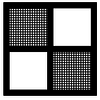
55. Kuronti ne Akwamu |
Kuronti and Akwamu. A symbol of democracy, sharing ideas, taking council. |

56. Kwatakye Atiko |
The back of Kwatakye's head. A symbol of valor and bravery. This symbol is also called Gyawu Atiko. It is said to be a hairstyle of Kwatakye, a war captain of old Asante. |

57. Kyemfere |
Potsherd. A symbol of knowledge, experience, service, keepsake, antiquity, rarity, and heirloom. From the proverb, "Kyemfere se odaa ho akye, na onipa a onwenee no nso nye den?" to wit, "The potsherd claims it is old; what about the potter who molded it?" |

58. Mako |
Peppers. A symbol of inequality and uneven development; from the proverb "All peppers on the same plant don't ripen at the same time." |

59. Mate Masie |
I have heard and kept it. A symbol of wisdom, knowledge, and prudence. From the saying, "Nyansa bon mu ne mate masie," to wit, "The hole of wisdom is 'I have heard and kept it'" |

60. Mekyea Wo |
I greet you. A symbol of greetings, recognition, and respect. When two Akans meet, they first greet each other before proceeding to do anything else. They greet not just to exchange pleasantries but because to greet is to recognize a fellow human being. |
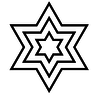
61. Menso Wo Kenten |
I am not carrying your basket. A symbol of industry, self-reliance, and economic self-determination. |

62. Mframadan |
Well-ventilated house. A symbol of resilience and readiness to face the vicissitudes of life. |

63. Mmeramubere |
Female cross. Symbol of warmth, sunshine, and vitality. |

64. Mmeramutene |
Male cross. A symbol of sunlight, warmth, endurance, and uprightness. |

65. Mmere Dane |
Time chanegs (times change). A symbol of the temporariness of good times. |
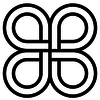
66. Mpatapo |
Pacification knot. A symbol of pacification, forgiveness, and reconciliation. |

67. Mpuannum |
Five tufts (of hair). A symbol of loyalty and priestly office |

68. Nea Ope Se Obedi Hene |
He who wants to be a king. A symbol of the qualities of a leader, service, and leadership skills. From the expression, "Nea ope se obedi hene daakye no firi asee sua som ansa," to wit, "He who wants to be a king in the future begins by learning how to serve." |

69. Nea Oretwa Sa |
The path maker. A symbol for leadership problems, trailblazing, and the need for a leader to heed advice. "Nea oretwa sa" literally means "the one who is paving a path." The name of the symbol is derived from the Akan proverb, "Nea oretwa sa nnim se n'akyi akyea," meaning, "The one who is paving a path does not know that it is curved or crooked behind him." The imagery is that of someone clearing a bush to make a path. The maneuvers through the non-uniform terrain invariably lead to a path that is not straight, a fact that is obvious to onlookers though the paver himself may be oblivious to it as he busily undertakes his task. |
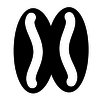
70. Nkonsonkonson |
Chain. A symbol of unity, community. |

71. Nkotimsefo Mpua |
The hairstyle of court attendants. A symbol of loyalty and a readiness to serve |

72. Nkrabea |
Destiny. A symbol of destiny, determinism, unequal distribution of talents, and inequality. From the aphorism, "Esono onipa biara ne ne nkrabea," or, "Onyame nkrabea mu nni kwatibea" which translate literally to "Everybody has their own distinct destiny" and "God's destiny cannot be circumvented" respectively |

73. Nkyemu (Nkyimu) |
The crossed divisions made on Adinkra cloth before the stamping of the symbols is done. A symbol of adroitness, precision, and quality craftsmanship. |

74. Nnamfo Pa Baanu |
Two good friends. A symbol of friendship, fellowship, and comradeship. From the aphorism, "Hu m'ani so ma me nti na atwe mmienu nam," (literally, "It is because of 'blow the dust off my eyes' that two deer walk together") or "Adwen yedwen no baanu" (literally, "Thinking is done in pairs"). Also, "Ayonkofoo baanu goro obaa koro ho a, ntotoee ba" (lit erally, "When two friends play with one woman, it brings misunderstanding"). |
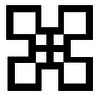
75. Nsaa |
A type of woven cloth, renowned for its quality. A symbol of excellence, genuineness, and authenticity. |

76. Nserewa |
Cowries. A symbol of affluence and wealth. Also a symbol of sacredness when used by priests. Cowries were traditionally used as money in parts of West Africa before the colonial era. In fact, the anglicized form of the Twi word for 'cowry'--'sedee'--is what was adopted as the name for the national currency when the nation weaned itself off of the Ghanaian pound after independence. |
|
77. Nteasee |
Understanding. A symbol for understanding and cooperation. |

78. Nyame Baatanpa (Awurade Baatanfo) |
God the good parent. A symbol of the caring and nurturing of God over all his creation. |

79. Nyame Biribi Wo Soro |
God, there is something in the heavens. From the saying, "God, there is something up there (in the heavens); let it come to me." A symbol of hope and inspiration. |
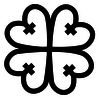
80. Nyame Dua |
God's tree (sacred stump). A symbol of God's presence and protection. |

81. Nyame Nti |
By God's grace. More literally, "Because of God." A symbol of faith and trust in God. The proverb associated with this symbol is, "Nyame nti, menwe wura," to wit, "Because of God (by God's grace), I won't feed on leaves (like an animal)." |

82. Nyame Nwu Na Mawu |
God won't die for me to die; a symbol expressing the immortality of the human soul. |

83. Nyansapo |
Wisdom knot. A symbol of wisdom, ingenuity, intelligence, and patience. The proverb associated with this Adinkra is "Nyansapo wosane no badwenma," to wit, "A wisdom knot is untied (only) by the wise." The Kwame Nkrumah University of Science and Technology (KNUST) uses Nyansapo in their logo and uses the associated proverb as their motto. |

84. Obohemaa |
Diamond. Obohemaa literally means "queen of stones" and in this case represents a diamond. It is a symbol of preciousness, gem, and treasure. From the maxim, "Wo de wo sika to aboo a, wowe," to wit, "If you use your money to buy (non-precious) stones, you eat them." |

85. Ohene Aniwa |
The king's eyes. A symbol of vigilance, far-sightedness, intelligence, protection, security, defence, authority, and power. From the aphorism, "Ohene aniwa twa ne ho hyia," to wit, "The kings eyes surround him," that is, "The king sees everything." |

86. Okodee Mmowere |
The talons of an eagle. A symbol of strength, bravery, and power. These attributes are derived from the character and traits of the eagle. |

87. Okuafo Pa |
Good farmer. A symbol of diligence, hard work, and entrepreneurship. |

88. Osram ne Nsoromma |
Moon and star. A symbol of faithfulness, fondness, harmony, benevolence, love, loyalty, and femininity. |

89. Owo Foro Adobe |
A snake climbs a raffia palm. A symbol of ingenuity, excellence, feat performance, and performing the unusual or impossible |

90. Owuo Atwedee |
Ladder of death. A symbol of the certainty and universality of death. |

91. Pempamsie |
Sew in readiness. A symbol of foresight, readiness, steadfastness, hardiness, valor, and fearlessness. |

92. Sepow |
Executioner's knife. A symbol of justice. |

93. Sesa Wo Suban |
Change your character. A symbol of warning against arrogance, bad manners, and dishonorable behavior. |

94. Som Onyankopon |
Worship God. A symbol of devotion and worship. From the expression, "Som Onyankopon" which literally means, "Worship God." |

95. Sunsum (Ntoro) |
Soul. A symbol of spiritual purity and cleanliness of the soul. The Akans believe that this is the part of God the creator that is transmitted to a person through his father. A person's mother cannot transmit sunsum to him. Instead, she transfers her mogya (blood) to him |

96. Tabono |
Paddle or oar. A symbol of strength, confidence, and persistence. These attributes are derived from the qualities required of one who paddles a boat. |
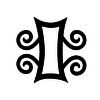
97. Tamfo Bebre |
The enemy will suffer; the enemy will stew in his own juice. A symbol for ill-will, jealousy, and envy. |

98. UAC Nkanea |
UAC lights. A symbol of technological advancement. |

99. Wawa Aba |
Seed of the wawa tree. A symbol of hardiness, toughness, and perseverance. |

100. Wo Nsa Da Mu A |
When your hands are inside (the dish). A symbol of participatory government, democracy, and pluralism. From the aphorism, "Wo nsa da mu a, wonni nnya wo," to wit, "When your hands are inside the dish, people don't eat everything and leave you nothing." |

101. Woforo Dua Pa A |
When you climb a good tree. A symbol of support for good causes. |
